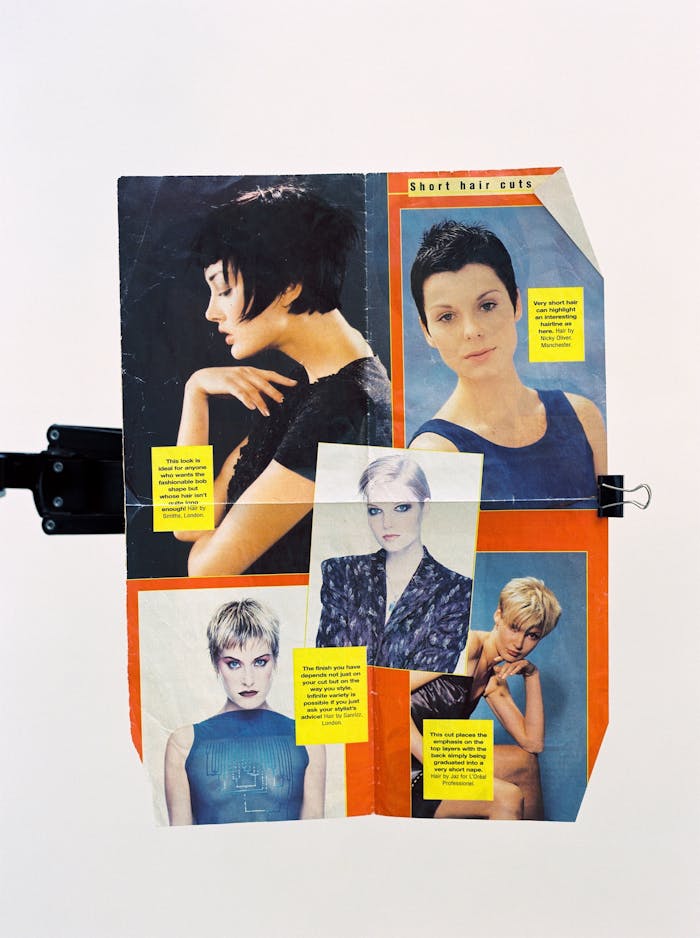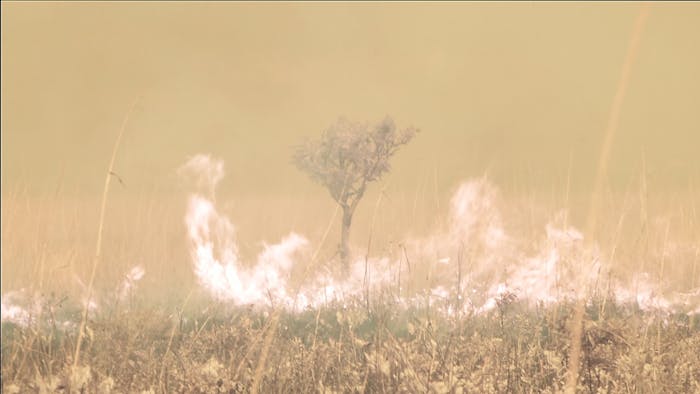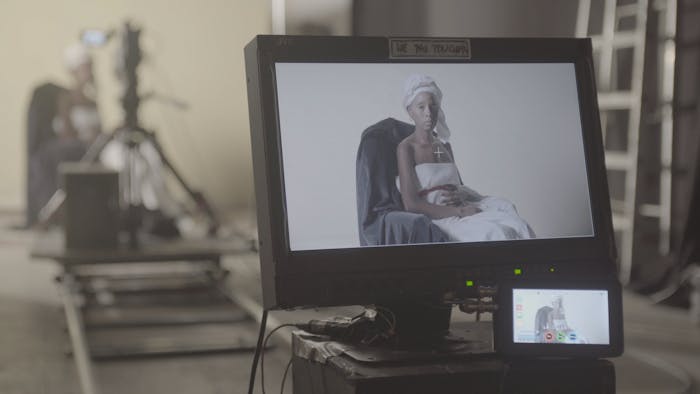Auguste Orts is a Brussels-based production and distribution platform for film and video. This year, they’ve been invited to curate the tenth edition of Contour Biennial of Moving Images, an exhibition and screening program showcasing work from local and international artists. Pieter Vermeulen spoke with two of the founding members.
Contour Biennial of Moving Images celebrates its twentieth anniversary. For the tenth edition, the Brussels-based artists’ platform Auguste Orts has been appointed curator. The news broke two years ago, but Contour was postponed a year due to the pandemic. Auguste Orts’ proposal was selected by an artistic committee from among 150 applications. Even if it fits into a current trend in the art world to give artists more curatorial autonomy, the decision is still remarkable given the biennial’s discourse-laden history. This time, the artists have decided to stay away from too much theory and not to follow the biennial format of a walk through the city. Their main concern is to bring people together around a screen. I spoke with two members of Auguste Orts, Herman Asselberghs and Anouk De Clercq.
PV: For those less familiar with your practice, who and what is Auguste Orts?
ADC: We started in 2006 and at that time we were four artists, Herman Asselberghs, Sven Augustijnen, Manon De Boer and me. There was also Marie Logie, who is the artistic director. We had the desire to create a platform to do the things we used to do on our own, as a one-man orchestra, and to share it with each other. So, it’s a distribution and production platform for the work we do, but also for the work of other artists. Every year August Orts produces and distributes the work of one, two, sometimes three other artists.
HA: Almost two years ago, we invited Fairuz Ghamman to become a full member. Since Auguste Orts is not a collective but a platform, we don’t make joint works. Each of us has his or her own path. As an organisation, we are subsidised by the Flemish Community for our operation, but the artists involved are not paid as staff. We are deliberately a small organisation, and we want to stay that way.
PV: Contour is a biennial for the moving image. Does the label of video art no longer apply?
ADC: I recently had a discussion with someone about this. The term video art is no longer used. Today it is called ‘artists’ moving image,’ a label we feel very comfortable with. For a very long time, as a filmmaker presenting work in film festivals and cinemas, but also in the visual art world, it was a difficult straddle. The two worlds didn’t know each other; they were completely different circles. For a few years now, more and more people have been making films and presenting them within the visual arts and seeking an exchange between the two. This makes for a rich scene, a fascinating community of makers moving in these two worlds.
HA: The label ‘video art’ stubbornly invokes the electronic medium. Nowadays, it remains sort of a misnomer for digital image production of all sorts, including installation art. ‘Artists’ moving image’ covers much more than that, including analogue film. Alongside the many dos and don’ts in the film industry, we are inventing our own rules that require new names.
PV: Both of you showed works at previous editions of Contour. What memories do you have of that?
ADC: I presented work in 2005 when Cis Bierinckx was curator. Manon De Boer, another Auguste Orts member, also took part. As with other editions of Contour, the artists were given their own location and visitors could view the works along a route through the city. I also remember rendering the work on my way to the opening. But I was just in time [laughs].
HA: I participated in 2009, under the curatorship of Katerina Gregos. As that show was organised as a walk through Mechelen, I showed my work in a medieval building along the trail. With this edition, we’re going in a different direction. We don’t want to send visitors on a city safari. Instead, we aim at solid exhibition and screening spaces. In Mechelen, however, C0N10UR still takes place along a ten-minute walk between the Museum Hof van Busleyden and nona arts centre.
PV: The slogan for C0N10UR is ‘We are rooted but we flow’, borrowed from Rosi Braidotti. Isn’t the concept of roots a bit tendentious?
HA: The tagline for our biennial springs from our situatedness. As citizens and artist-filmmakers, we are located in specific contexts, at the intersection of various practices and different sociocultural, historical and geographical contexts. Being situated implies groundedness as well as agility and mobility. As Eric B & Rakim stated before: ‘Cause it ain’t where you’re from, it’s where you’re at.’ It’s where we’re at. Braidotti adapted Virginia Woolf’s one-liner by changing ‘I’ to ‘we.’
ADC: Writer Taiye Selasi once said in a lecture, ‘Don’t ask me where I’m from, ask me where I’m a local.’ That statement was also on our minds. We work with artists who come from all over and have landed in Brussels. That, of course, is also the attraction of the city. Brussels is a landing place for birds of paradise who fly in from everywhere and who find each other quickly because of the relatively small scale of the city. As a result, collaborations and exchanges happen much faster, more so than in other European capitals. Internationally, this scene really stands out, which is something special.
PV: Which is why it is also your starting point for the upcoming edition?
ADC: What we proposed was a kind of celebration of the scene that we love and enjoy being a part of, creators moving within the field of artists’ moving image. For C0N10UR, we wanted to work with what we know, and not have to spend the limited budget on flying artists over, transportation and so on. Hence, we wanted to invite artists who live and work in Belgium. We are not curators who go around scouting and visiting studios, although of course we see a lot abroad when we present our own work there.
PV: You invited six artists to create a work around a film by Chantal Akerman.
HA: At Auguste Orts, we think Akerman is incontournable when it comes to personal filmmaking. Probably, one of her most personal films is News From Home (1976), a portrait of herself through her mother in a city. We asked six artists [Eva Giolo, Rebecca Jane Arthur, Katja Mater, Maaike Neuville and Sirah Foighel Brutmann & Eitan Efrat] to draw inspiration from Akerman’s film for an ensemble film of five short films that will be screened continuously at nona arts centre. Fairuz [Ghamman] has supervised the project, and it is also nona’s first audiovisual production.
PV: Most of the works in the biennial are shown in a cinema setting. Was that a conscious choice?
ADC: Absolutely. We want to make the case for cinemas and see the visit as a collective experience. This is also part of our idea of ‘coming together,’ the idea of watching movies together. Another important part of the program is that we show films at Cinema Lumière, Mechelen’s new city cinema. It’s a strategy to show the kind of films we love in a regular art house cinema. It also means that you can offer very good conditions to the artists and really organise a release of films that would otherwise never be shown there. Auguste Orts also produced two films, by Annik Leroy & Julie Morel and by Léonard Pongo, which will have their premiere at Cinema Lumière.
At Museum Hof van Busleyden, instead of a group exhibition, we have chosen to install a large projection wall and a tribune, presenting a program of short films and film clips by artists such as Brahim Tall, Mischa Dols and Camille Picquot. Also on view will be a series of paintings by Melissa Gordon and a new work by Subversive Film titled Assembly.
PV: You chose not to impose any particular theme for this biennial, but it all sounds pretty political, doesn’t it?
ADC: The whole conversation around Contour started for us with Frederic Rzewski’s musical piece Coming Together (1972), which will be performed live at the opening of the biennial and will be available in one of the exhibition spaces for people to listen to.
HA: Rzewski was an American minimalist composer with explicit political ideas who lived in Brussels for decades. Coming Together was inspired by a riot at the Attica prison in the United States. A fierce piece, at the crossroads of composition and improvisation. The live performance of the piece is the opening concert of C0N10UR. It will also be bookended by Rzweski’s work since the closing concert will feature his seminal composition The People United Will Never Be Defeated (1975).
PV: There are also two satellite locations, argos in Brussels and Kunsthal Extra City in Antwerp. What is happening there?
ADC: For the tenth edition — twenty years of Contour — we felt it was important to show that the biennial also lives outside Mechelen. We want to emphasise that it is a landscape that holds together thanks to partners such as argos, Extra City, but also STUK, Escautville, KAAP and others. At argos, we are showing Small Acts of Violence by Aay Liparoto, an installation with a ‘cinematic VR work,’ as they describe it. It addresses how abuse can be part of domestic love relationships. The fact that the artist is using VR also means that the viewer’s position is questioned. At Kunsthal Extra City, there will be a solo show by Elephy, the platform of Rebecca Jane Arthur, Chloë Delanghe, Eva Giolo and Christina Stuhlberger. These are artists whose practices we have followed from the beginning. Almost all of them have also worked with Auguste Orts.




